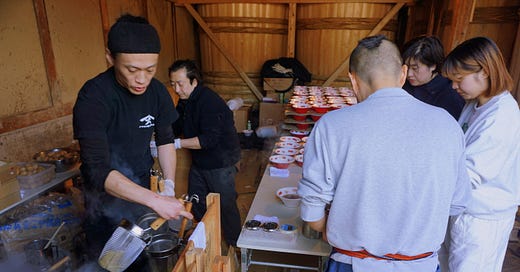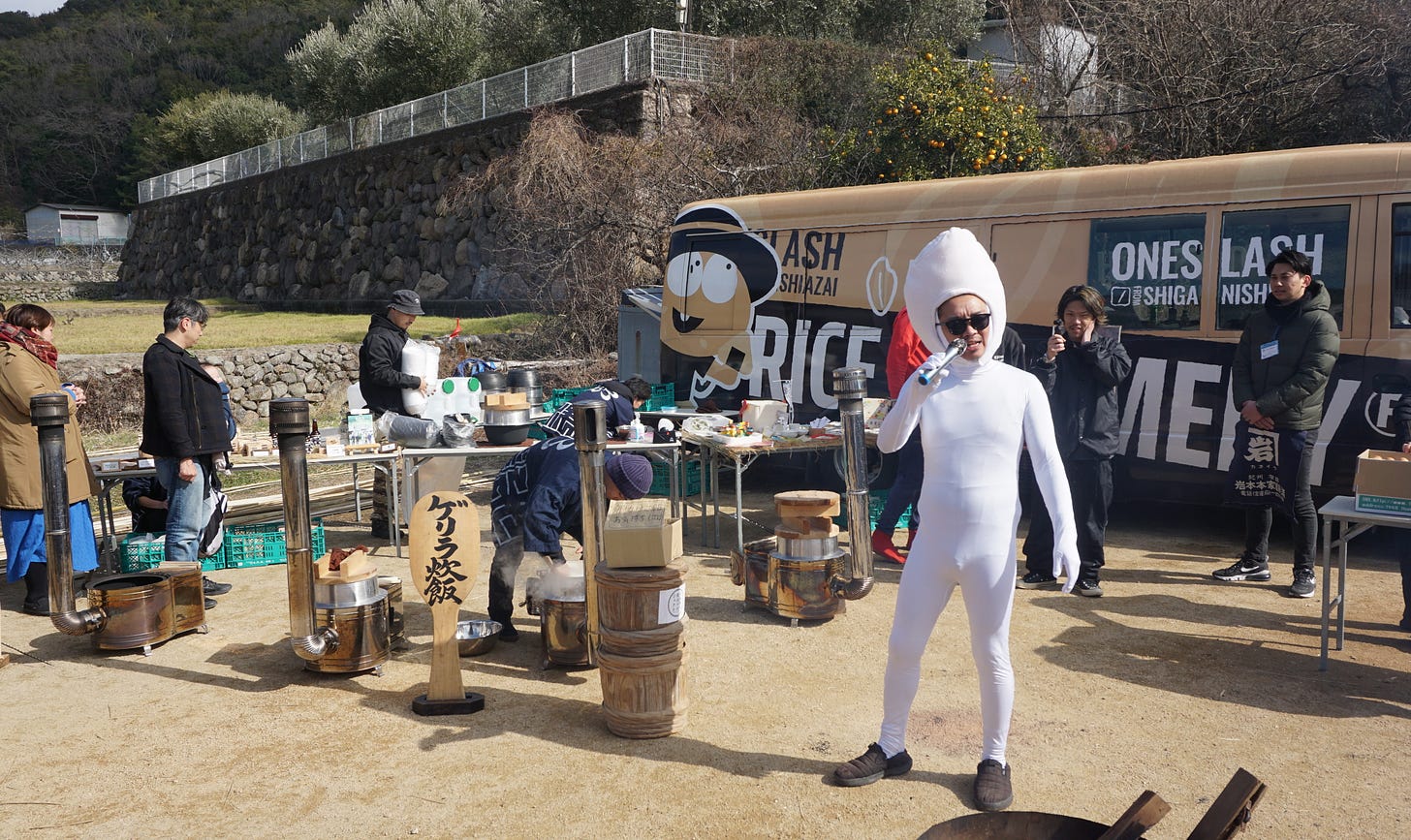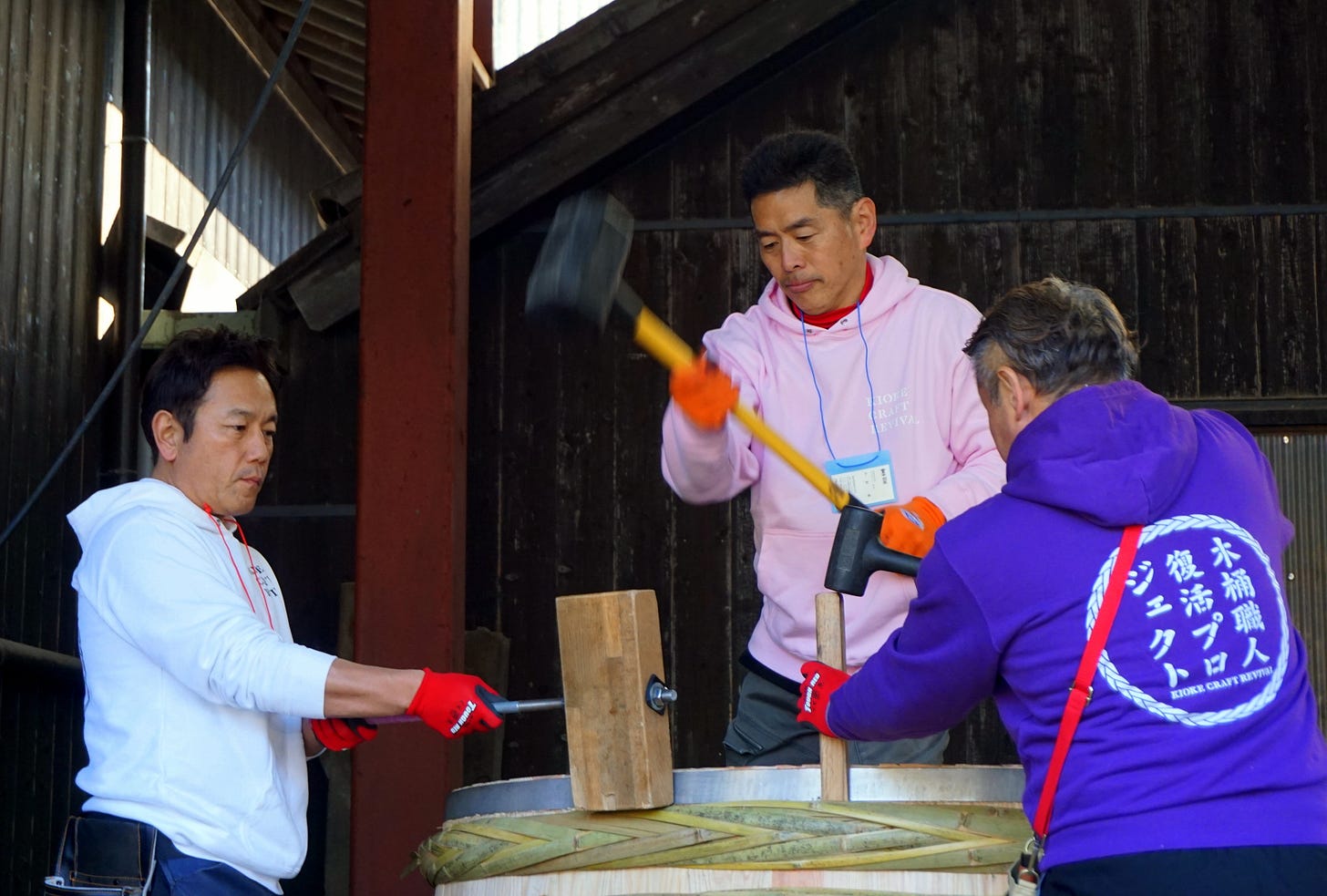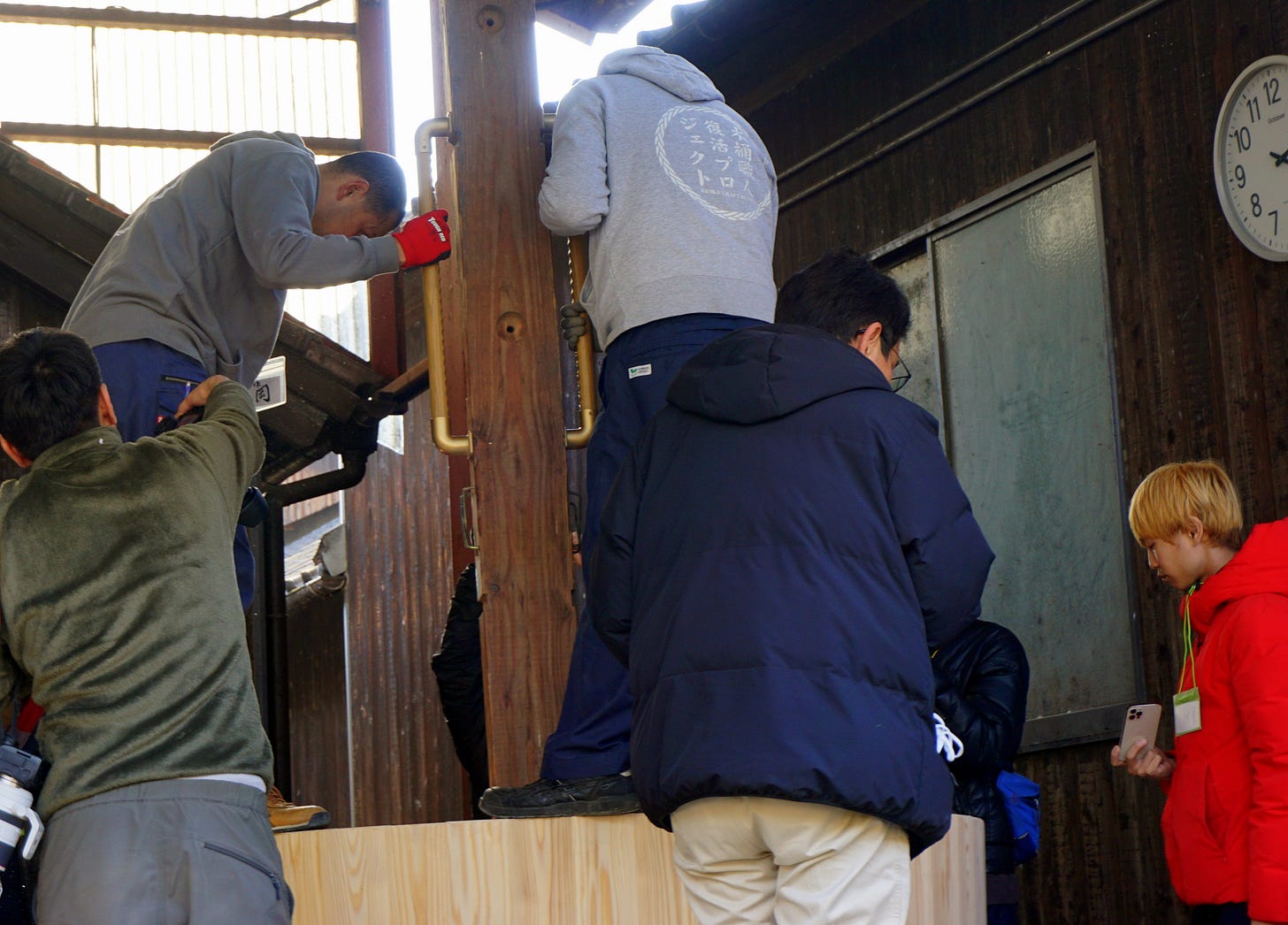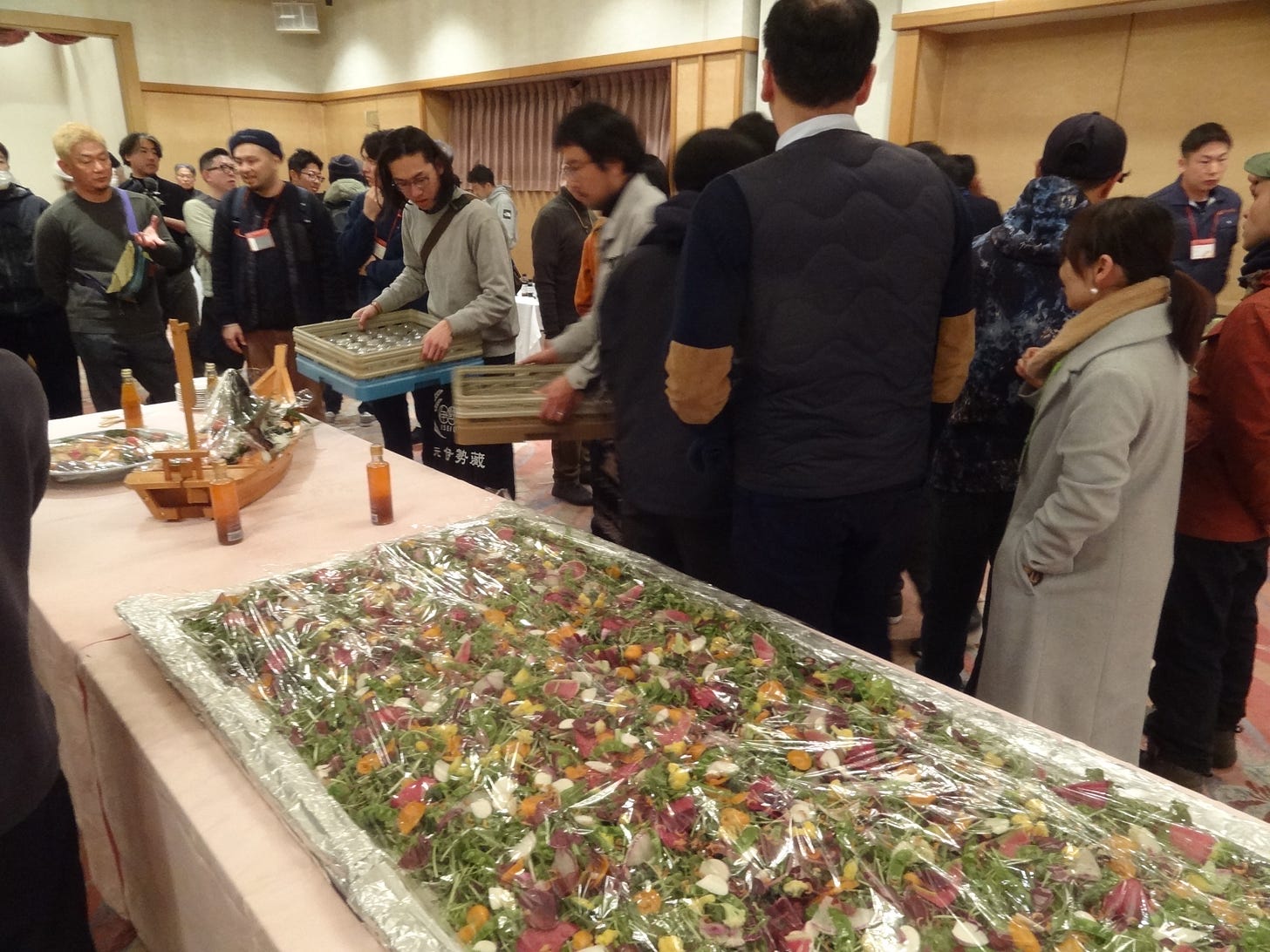Dear readers, these are the links to part 1 and part 2, in case you have missed them.
By now, it was time to eat. During the first two days of the Summit, two different ramen chefs would feed the starving crowd with their original creations. Today, Kuroki Naoto from Tokyo’s Omotenashi Kuroki was busy at work inside one of the brewery’s storerooms, and everybody was getting ready for lunch when a strange minivan appeared out of the blue. The big letters on its side read “Rice Is Comedy.” As everybody gathered near the van, a motley crew of long, dyed-haired, ear-pierced, rough-looking guys came out of the van. They looked like a mix between an itinerant comedy troupe and a biker gang. Before we could recover from the surprise, their MC, dressed like a grain of rice, started addressing the crowd in a high-pitched voice. “Hello! We are Rice Is Comedy and come from Nagahama, a city in Shiga Prefecture on the northernmost tip of Lake Biwa.”
In the meantime, other members of the colorful gang were setting up four old-style rice cookers. It turns out that this group went around Japan spreading the joys of rice culture. On this day, they were preparing two types of rice: Koshihikari and Inochi no Ichi.
I already knew Koshihikari. First created in 1956 in Fukui Prefecture, it is one of the most popular varieties of rice in Japan and is even exported to other countries as a premium product. On the other hand, I had never heard of Inochi no Ichi. I later found out that it was a sort of “alien rice.” While many varieties are commonly created through genetic manipulation or artificial crossbreeding, Inochi no Ichi had been accidentally discovered in a mutant strain.
Rice-kun, the MC, went on to explain that his group was into “guerrilla rice cooking” and for just 100 yen, we could choose our favorite kind of rice, shoyu and/or miso (many bottles and packages were lining up on a few tables), then pick one raw egg, mix everything together and make our personalized tamago-kake gohan (egg on rice). This is a popular Japanese breakfast food, but it also comes in handy as a quick energy shot that at this point, everybody sorely needed. Meanwhile, the sun had managed to break through the clouds, and we were able to enjoy our food under a glorious blue sky.
After lunch, the participants divided into several discussion groups. Among them, one was for shoyu makers, one for shoyu lovers, and another one for people who used kioke to make products other than shoyu. I joined the English-language group because I was curious to learn while the foreign guests had joined the Summit.
Mike Fung, for instance, was a Hong Kong national who had migrated to Australia. He had always wanted to make his shoyu, so five years ago, he took part in this event for the first time to see how they made it in Japan.
Mike explained that the Chinese style of soy sauce-making is quite different since they don't use wood at all. In Hong Kong, Taiwan, and even Korea they use ceramic and don't mix the sauce; they just leave it under the sun for a shorter period.
“I personally find that keeping it in wooden barrels for longer is better,” he said, “because the resulting sauce has more character. Chinese sauce, in comparison, is salty, and I find it a little boring. So, I'm now trying to replicate Japanese shoyu.” Mike added that he was still experimenting, but he definitely wanted to buy a wooden barrel, so had ordered two 200-liter kioke made from American oak.
I also met a young couple from Quebec, Canada: Julien Clot and Vivian Kaloxilos. Julien makes shoyu, kimchi and other fermented foods at SymbiOse AlimenTerre, while his wife Vivian is a soil ecologist whose company, Docterre, offers consulting and laboratory services, helping farmers revive their soil ecosystems and bring back biodiversity.
Alice Malice comes from France. Five years ago, she started researching fermentation culture in Japan and one day was invited to Shodoshima and had a chance to visit Yamaroku. "When we entered the warehouse and I saw all those huge wooden barrels, I was transfixed," she said. "From that moment on, I became a shoyu fan, came back the year after for the Summit and again last autumn, after the pandemic, to do more research." Now Alice helps at the brewery while visiting other shoyu makers with the aim of writing a book on the subject.
The group was also comprised of another French couple and two English-speaking Japanese, including Okamoto Kosei, a young business student who also helps his father at their shoyu brewery.
The participants in this discussion agreed that it's important to educate people and spread the word about shoyu and other fermented products.
The discussion sessions were over, and it was now back to kioke-making. Now it was time to put in the taga. The bottom hoop is actually made of stainless steel, while the other seven, as we have seen, are made of woven bamboo strips. The giant barrel was turned upside down to slide the hoops from above, starting with the one with the widest circumference. The precise location where each taga would be placed had been determined and marked in advance on the surface of the barrel with chalk.
Each hoop was driven in with hammers. This is where the hard work began. In order to insert the taga evenly, four people must climb on a scaffold, place a wooden stick on the hoop and hit it with a hammer. Slowly moving around the barrel, they shout “se~no!” (the equivalent of the English “one, two, go!” or “heave, ho!”) in unison before dropping their hammers at the same time. “Se~no!” DON!... “Se~no!” DON!
The draftsmen must be careful not to hit the joints as they will break. Also, they obviously don’t want the hoop to be too loose, but if they hit it too hard, it will shorten its life.
The last step in kioke-making is adding the bottom of the barrel. Bottom plates are made of thicker pieces of wood connected with bamboo nails to form a single board, which is then cut into a circular shape. This process requires precision, as differences in size or gaps can cause leaks.
Once the bottom plate is dropped inside the barrel, it is hit from above with a pillar. A large square piece of wood called a dotsuki is lifted and dropped while two people go inside the tub. Rather than keep hitting one spot, the people on top of the barrel have to move around to lower the bottom evenly. Again, one shouldn't put too much weight on the pillar. Standing on the top of the kioke, the expert craftsmen lift their torsos and concentrate on the soles of their feet, paying attention to where and when to drop the pillar. It requires a lot of concentration, and from where I stood, I noticed that they were sweating even in the middle of winter.
Every time it was dropped, the pillar made a low sound – BOOM! – that slowly changed in pitch as it gradually wedged the thick wooden plate at the bottom. The sound reverberated inside the tub, creating a unique and powerful sound.
At last, a new kioke was complete
All that remained was to add water and check to make sure there were no leaks. Later, the craftsmen would shape the bamboo hoops around the barrel by scorching them with a burner, sand the kioke surface, and place the kioke in the warehouse, ready to be used for 100 years and more.
At the end of a fun but hard day of work, it was now time to party. So we all moved to a nearby hotel where we stuffed ourselves with all kinds of delicacies. When we arrived, a huge colorful salad had been already laid on the table, ready to be dressed with a mix of shoyu and local olive oil. Then, the courses started to appear one after another: first sashimi, then different kinds of roasted meats and big plates filled to the brim with different kinds of vegetables and meat- and fish-based morsels.
Of course, we helped ourselves to the usual array of shoyu and miso, while to wash it all down, we could choose between oolong tea, beer, wine and sake.
The interesting thing about shoyu is that, while most supermarkets only carry one kind (usually dark, salty, strong-flavored, factory-made), there are actually five different kinds of shoyu.
・Shiro Shoyu (lit. “white shoyu”) is pale amber-colored and has a bland flavor but with strong sweetness and a unique fragrance. It is used in cooking dishes such as soups and chawanmushi (steamed egg custard).
・Koikuchi Shoyu (dark shoyu) is the one that most people know as it accounts for around 80% of domestic production volume. Other than saltiness, it has deep umami, rounded sweetness, refreshing acidity, and bitterness that brings the tastes together. It is a general-purpose condiment, usable in cooking or at the table.
・Usukuchi Shoyu (light-colored shoyu) originated in the Kansai region (Osaka, Kyoto) and has around 10% more salt than common soy sauce. Its fragrance is reduced to bring out the original flavors of the ingredients. It is used in cooking such dishes as sugar-boiled stews.
・Tamari Shoyu (Tamari) is mainly brewed in the Chubu region (e.g. Nagoya) and is characterized by thickness, dense umami, and a unique fragrance. Besides sushi and sashimi, it is used in grilling and boiling.
・Saishikomi Shoyu (refermented shoyu) is a special product. While common shoyu is typically made by mixing the koji with brine for brewing, this type is a blend of different kinds of shoyu. It is dense in color, flavor, and fragrance, and is also known as “sweet soy sauce.” It is mainly used at the table for flavoring sashimi, sushi, chilled tofu, etc.
(To be continued. Last part coming soon!)

